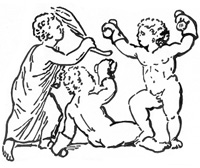“James, I enjoyed the Ghetto Grocer quite a bit—although I had to cover it in a brown paper jacket at work! I am an H.R, manger for a regional retailer who has to staff locations from the ghetto, to the suburbs, and also in upscale locations. On the upscale end our locations are not situated in areas with a desirable force pool, due to the spoiled nature of the rich youth. In our depressed urban locations we can pull in no outsiders, and the locals have been raised in such a way as to be outright rude to customers, belligerent to coworkers, and defiant to management. How do you deal with 18 years of negative conditioning?”
-Mike
Okay Mike, there are a lot of good people in middle income neighborhoods, no good people in upscale neighborhoods, and only a few good ones in low income neighborhoods.
I see no angst from you concerning your middle income locations. Most people do not realize that food retailers primarily provide local jobs and skim off little net profit. The fact is that the best retail employees are not from the neighborhood, but are people hungry to work their way out of a less affluent situation.
For instance, Towson Town Mall, is staffed by people from Essex, the low end of the same county, who take the bus home with me. These are the best people in Essex. If they have success in their Towson job, their next step is to move to Towson, and so on.
Another for instance is the Mondawmin area where the recent riots took place. There are some good people in that area, and they all want to get the hell out. I used to hire Mandawmin people at my East Baltimore location, which meant I got the cream from that neighborhood while the local grocer was stuck with the crud.
Here are your action plans.
The Low Income Area Prospect
1. Use your middle income locations for training stores. Start no one with management potential out at the upscale and low end locations.
2. Take a good worker from a low end area and train them on procedure and customer service in the middle income area, which is the most diverse—and hence best—training ground.
3. Promote that low end person to the upscale location to hone customer service skills.
4. Promote that person again to their own neighborhood, making certain that you tell them that this is not their destination. After all, they came to you because they wanted out. With their local knowledge they will be the best person to train and direct the rude and aggressive people from that area, as they will stand as an example of success and be able to speak the local dialect.
5. This person should be rotated out periodically so as not to get beaten down by the setting and eventually promoted to a regional training team which can trouble shoot H.R. issues and insure training standards company wide.
The Middle Income Area Prospect
1. Hire and train him in his area as he will learn how to apply local tastes and manners to his inventory control and customer service skill set right out of the gate.
2. Promote him to the low end location, letting him know this is not his destination, but a test.
3. Promote him to the high end destination.
4. Promote him back into the middle income market with his expanded skill set and increased understanding of the culture some of his employees will be coming from.
5. Since these people are more common than the quality people exiting the ghetto they will get most of the location promotions. Look for the ones who excel in. H.R., inventory management and creative thinking to promote to your regional team, rewarding the customer service standouts with better location posts; directors of your biggest volume outlets.
I hope this is some help Mike. My overall theme is that the skilled H.R. specialist is the rarest human resource, and should be placed in a roving capacity as part of a trouble shooting team that will include operational specialists for training staff and management. The operational guys will mostly train your department heads while the H.R. guys would train entry level staff and consult with the location director. Understanding how close your margins are I suggest this team do actual work on site and add to production while on site while transmitting skills. It is more effective to teach customer service skills and team work while you are training employees on operational procedures, in a hands-on capacity, that make their tasks easier to resolve.
The usual method of having senior employees train junior employees is based on medieval apprenticeship methods and is not effective in a wage slave situation, as increased skills in a new employee threatens the sense of security of an established employee, as promotion is the only avenue of advancement, and the aspect of legacy and art preservation are not motivating factors.











